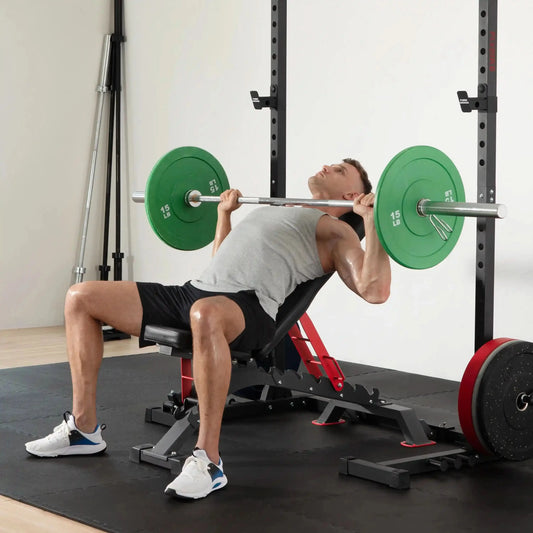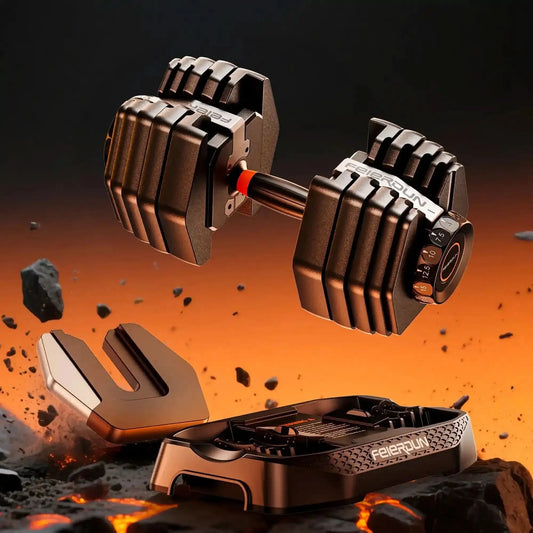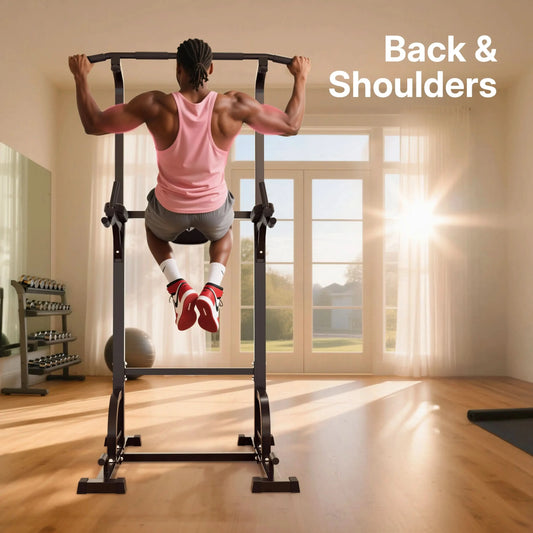The bench press is a basic exercise not only for muscle growth and upper body strength, but also an indicator of overall strength. The dumbbell bench press (DBBP) and barbell bench press (BBBP) are used most frequently across their variations. Many wonder which bench press method is more effective for increasing strength and muscle mass; this article will discuss that.
The Fundamentals: What is Dumbbell vs Barbell Bench Press?
The difference is mainly in equipment and movement mechanics. Dumbbells are unilateral; they encourage each arm to move separately, so you can work on your strength imbalances and perhaps even generate better muscle activation because using a dumbbell lets you fulfill more stabilization demands. Barbells, however, accommodate heavier loads and a non-stabilized movement pattern that can favor maximal strength development.
What is the Dumbbell Bench Press?
Dumbbell Bench Press includes two separate weights (dumbbells), one in each arm from the chest to full extension, this time on a bench. This variation is a lot more about stability and balance than its barbell version.
Advantages:
● Greater Range of Motion (ROM): Enables you to stretch and contract the pecs more, which can promote hypertrophy.
● Better imbalances correction: Each arm can work independently, thus helping you to correct strength differences on one side of your body.
● Easier on the Joints: More natural mechanics means less wear and tear on your shoulder joints.
Disadvantages:
● Decreased Maximal Load: As a generalization, the load lifted is lower with dumbbells than with barbells, which may limit maximal strength potential.
● Higher Level of Coordination: You have to coordinate two different weights, so it requires a significant amount of coordination and control on the part of a beginner.
What’s a Barbell Bench Press?
A typical free-weight bench press exercise, this
barbell is fully loaded and ready to handle even the most grueling workouts. You can use your bench press barbell on its own in any number of lifts. This exercise is frequently used to build strength.
Advantages:
● Increased Load Capacity: Can handle heavier weights, which will help us get stronger.
● Simplified form: The Barbell is stationary, offering a clear-cut path of movement, particularly for novices.
● Strength Development Efficiency: Perfect for individuals trying to focus on peak strength.
Disadvantages:
● Decreased ROM: That locked grip may keep your movement in check and even diminish how much muscle you activate.
● Muscle Imbalances: With the barbell, both arms can pick up slack for each other; this won’t be as effective as dumbbells to address strength imbalances.
● Risk of Injury Without a Spotter: Performing heavy weight lifting without a spotter can put you at an increased risk for injury since failing the lift is dangerous.
Which is More Recommended, the Barbell Bench Press or the Dumbbell Bench Press?
Barbell bench press has been found to have greater EMG activity in the pectoralis major, anterior deltoids, and triceps compared to dumbbell bench press. This is due to the fact that heavier loads can be lifted with a barbell, which altogether recruits more muscle. In training, I’ve noticed that barbell work allows for progressive overload more consistently, helping lifters push past plateaus. However, dumbbells still have their place — they challenge stability and highlight strength imbalances that the barbell can sometimes hide.
Joint Mobility and Muscle Balance
The dumbbell press allows for more freedom of movement, so you can stretch deeper at the bottom of the press and contract your chest better at the top. This can be responsible for better muscle development and balance. Also, because each arm is operating separately, dumbbells can actually help fix muscular imbalances more than barbells do.
Safety and Injury Prevention
Safety is of the utmost concern in any form of strength training. The barbell bench press, particularly when supporter-free and done with heavier weights, puts you at greater risk of injury if a lift is not completed.
Instead, the use of dumbbells allows an easier escape from a failed repetition by dumping the dumbbells to the side and producing less loading on the rotator cuff. And because they’re more natural for your wrists and shoulders, you may be less at risk for joint strain.
To maximize pure strength development, the barbell bench press is typically a better option, as you can lift heavier weights. In addition, with a fixed barbell, more coordination is required as they have variation in the grip at different weight increments. This enables greater control and therefore also helps you train more efficiently. However, introducing the dumbbell bench press can improve the stabilizing muscle activation to reduce muscle imbalances, thus developing more strength.
What’s Better for at-Home Workouts?
For home workouts, the dumbbell bench press is frequently more convenient. Dumbbells take up less room, are much more portable than a barbell system, and offer up an entirely different series of exercises that you can do at home. And it is safer than ever, as dumbbells can be dropped safely if a lifter fails.
Dumbbell vs. Barbell And When To Use Each
The debate between dumbbells and barbells isn’t about which is better; it’s about when and how to use them. Each brings a different kind of power to your chest training. Dumbbells demand balance and control, forcing every stabilizer muscle to engage. They let you lower the weight deeper, stretch the chest more, and correct side-to-side strength gaps. This makes them perfect for sculpting balanced muscle and keeping your joints happy.
The barbell bench press, on the other hand, is where pure strength is built. Because both arms move together, you can load more weight, focus on pushing explosively, and progressively overload the muscles for size and power gains.
The smartest lifters don’t choose between the two; they rotate them strategically. Start the week heavy with barbell bench presses to develop raw force. Midweek, switch to dumbbells for deeper muscle activation and joint-friendly volume. Finish the week with accessory chest moves like flyes or dips to fine-tune definition and endurance. Together, they create a complete chest routine that builds strength like a powerlifter and symmetry like a bodybuilder.
Common Mistakes to Avoid
Even seasoned lifters can fall into some of these traps when bench pressing, whether with dumbbells or barbells. Avoiding these mistakes not only improves the results, but it is also necessary to avoid injuries.
Shortcutting the Warm-Up
One of the most frequent mistakes is blowing off a good warm-up. Warm-up sets help increase blood flow to the muscles, allow joints more freedom to move, and lubricate the muscles while also prepping the nervous system for heavier loads. Some minutes of expenditure in dynamic stretches and shoulder rotations, light press sets can go a long way to preventing strains/injuries on your main lifts.
Over Ego Lifting
A lot of lifters like to lift heavy and sacrifice technique for the amount of weight. Too much weight can make it difficult to perform the exercise with good technique, lead to less muscle activation, and increase your risk of shoulder, elbow, or wrist injury. Work on getting your form down first, and then slowly add weight to force your muscles to work.
Abandoning Muscle Imbalances
A second mistake is failing to address muscular imbalances. With barbell bench presses, your stronger arm can compensate for the weak side, whereas with dumbbells, you help guarantee equal work from both sides. Unilateral exercises allow you to address such imbalances so that they do not grow into chronic strength or injury issues.
Bad Bench and Grip Setup
Using a poor position against the bench and gripping with the hands is a good way to sacrifice effectiveness while risking injury to joints. Steady your feet, maintain a neutral arch in your back, and keep a neutral wrist to get stronger power transfer and to stay safe.
Over Speed Movement
Lifters bring the weights down too fast, or they bounce them off their chest. Controlled movements are the best way to work your muscles and prevent injury.
By not making these mistakes, you’ll have safer and more effective training as well as maximized strength and muscle gains. Correct preparation, guided technique, and conscious correction of imbalances are the secrets to lasting success.
Recommended Equipment for Your Bench Press Journey
● Barbell +
Weight Plates: If you love strength training, owning a regular
barbell and some weight plates is essential.
●
Benches: Using an adjustable bench will allow for several incline and decline positions for a wider range of exercise options.
Conclusion
In conclusion, the dumbbell and barbell bench presses offer their own advantages and things to think about. If you’re trying to build the greatest amount of strength and power, a barbell bench press is stronger. But for correcting imbalances, increasing mobility, and decreasing stress on your joints, the dumbbell bench press is king. Using both of these moves in a routine can give an all-around upper-body training.
FAQ
Is the Barbell Bench Press or Dumbbell Variations Safer?
Dumbbells are also considered to be a safer option than barbells for most, as they can easily be adjusted and would arguably lead to fewer accidents for those working out without an attentive spotter. With dumbbells, if you can’t make the lift, you just drop the weights to your side without any danger of being trapped under a bar (a very real risk when it comes to barbells).
Dumbbells also allow for a more natural path to the wrists and shoulders, lessening joint stress while decreasing the risk of repetitive use injury. This is what makes dumbbells so good for beginners, home workouts, or people coming back from shoulder and wrist injuries.
Is it possible to develop the same mass in muscles through dumbbells rather than a barbell?
Yes, dumbbells can take the archetype of barbells when it comes to building mass, provided that you know how to use them properly and progressively overload your muscles. Because dumbbells can offer a greater range of motion, and each arm moves independently, they effectively engage the chest, shoulders, and triceps more equally than the barbell bench press does, maybe compensating for any imbalances that might not be as readily apparent if you only lifted with the barbell. With consistent training and progressive loading, it is possible for hypertrophy to occur with the dumbbell bench very similarly to the barbell bench press.
Should beginners start with dumbbells or barbells?
For novices, dumbbells are often the safer, more effective option to start. They assist in teaching proper movement mechanics, developing coordination, and preventing injury from too heavy loads being lifted too fast. Unilateral training becomes more important as you get serious about strength because beginners will favor one side of their body over the other when they’re lifting, and dumbbells require that they develop equal strength on both sides.
Which one naturally develops a bigger chest faster?
Barbell bench press may cause the chest to develop in terms of size a little faster since it allows you to use more weight than dumbbells, which means your pec muscles are under more mechanical tension. You are getting hypertrophy, and in a major magnitude with heavy weights. Dumbbells can yield an awesome chest development as well, especially when performed with good form, a full range of motion, and progressive overload. To maximize results, a hybrid-barbell-and-dumbbell regime can fast-track chest growth through the advantages of heavy load strength and balanced muscle stimulation.














